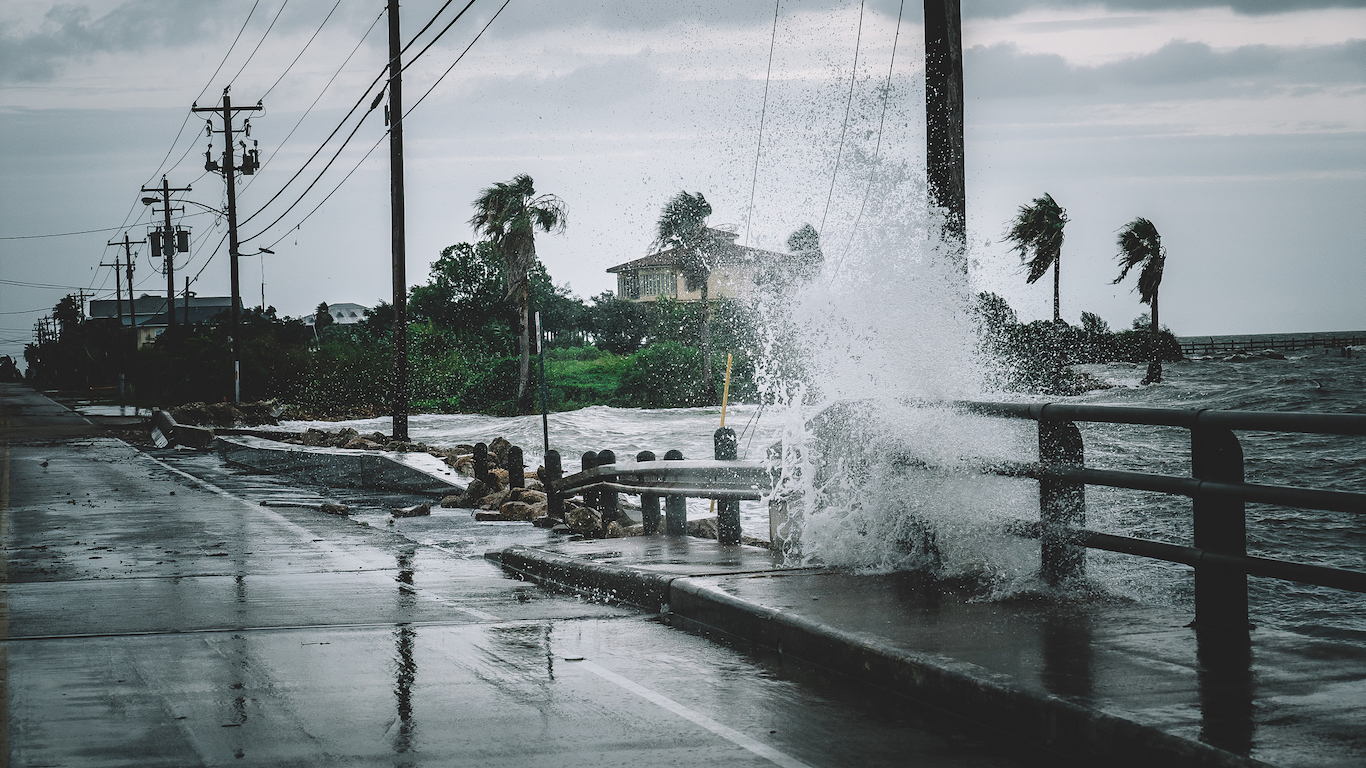
There are about 13,000 miles of coastline in the 48 contiguous United States, and by the end of the century, these contours will be greatly altered by climate change.
By the close of the 21st century, about 2.5 million properties worth $1.07 trillion, in cities and towns along the coastline will be at risk of chronic flooding, according to a report from the Union of Concerned Scientists, a nonprofit science advocacy organization. Chronic flooding, as defined by the scientists group, means flooding that occurs 26 times a year or more.
24/7 Tempo has identified the 21 beach towns in the United States that will soon be under water, based on data in the Union of Concerned Scientists report “Underwater: Rising Seas, Chronic Floods, and the Implications for US Coastal Real Estate.” Areas were ranked by the total number of homes that will be at risk of flooding by the year 2060.
Rising waters will have far-reaching implications for the economy. Apart from the impact on financial and real estate markets, town infrastructure such as roads, bridges, power plants, airports, public buildings, military bases, would be at risk of more frequent inundation. These are the disaster scenarios caused by climate change.
Chronic flooding also will have a social impact as well, as beloved destinations holding memories of boardwalk strolls, young romance, crashing ocean waves, and greasy summer food are inundated with rising waters and could become virtually unlivable. These are the summer getaways we’re losing to climate change.
Some areas of the nation, such as coastal Louisiana and the eastern shore of Maryland, are already facing the reality of chronic flooding, according to the report.
Click here to see beach towns that will soon be under water
Click here to read our methodology

21. Ventnor City, New Jersey
> Total population (2016): 10,505
> Homes at risk: 3,615
> Pct. of total pop. in at risk homes: 46.2%
> Value at risk: $850.0 million
Ventnor City, New Jersey, is a small beach resort about 4 miles south of Atlantic City. According to a report published in 2016 by Climate Central, an organization of scientists and journalists researching and reporting on the impact of changing climate, Ventnor City experienced 229 coastal flood days in the period from 2005 to 2014. That was more than twice as many coastal flood days as the previous 10-year period.
[in-text-ad]
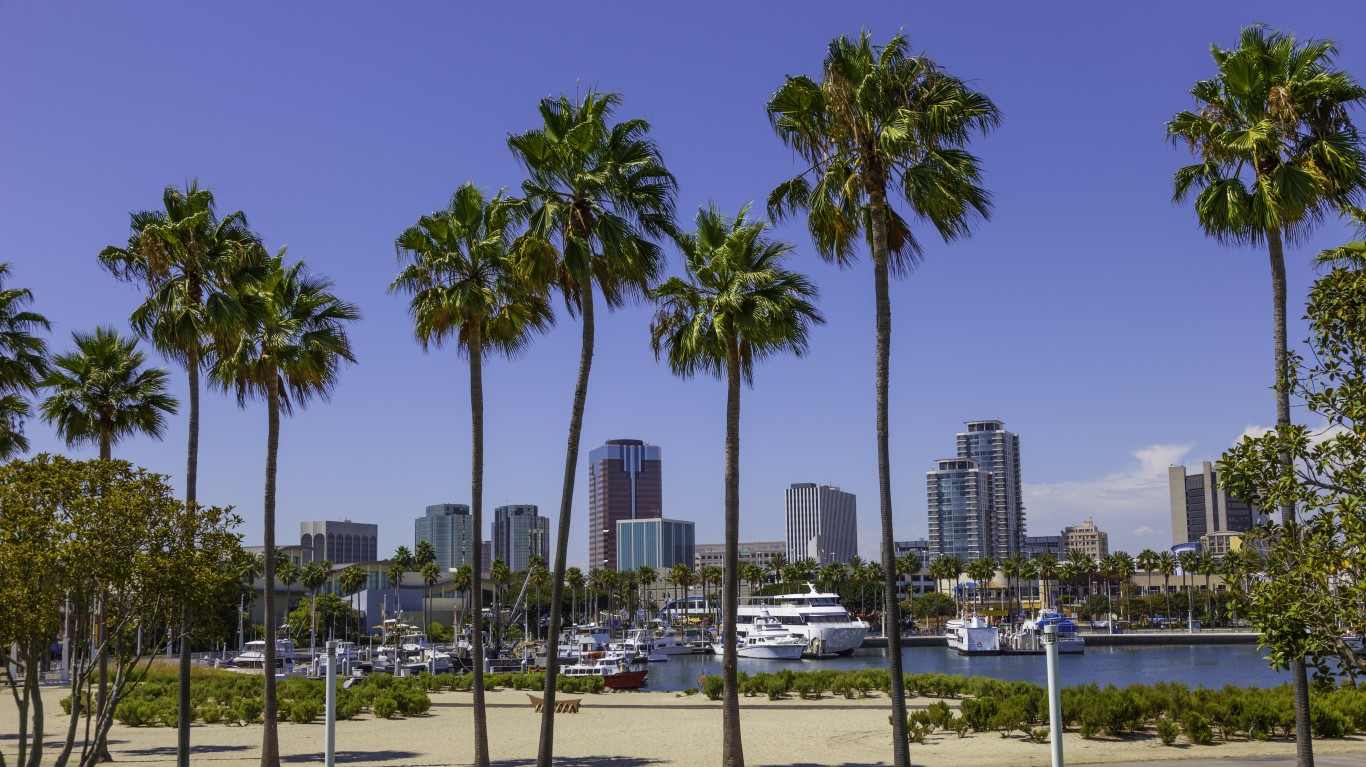
20. Long Beach, California
> Total population (2016): 469,793
> Homes at risk: 3,710
> Pct. of total pop. in at risk homes: 19.8%
> Value at risk: $2.50 billion
Long Beach, California, about 25 miles south of Los Angeles, is the most populous city on this list of beach towns, with nearly 470,000 people. The city is developing its first plan to address climate change, the Climate Action and Adaptation Plan. Long Beach had 60 coastal flood days over the 2005-2014 period, compared with 36 over the prior 10-year period, according to a Climate Central report published in 2016.
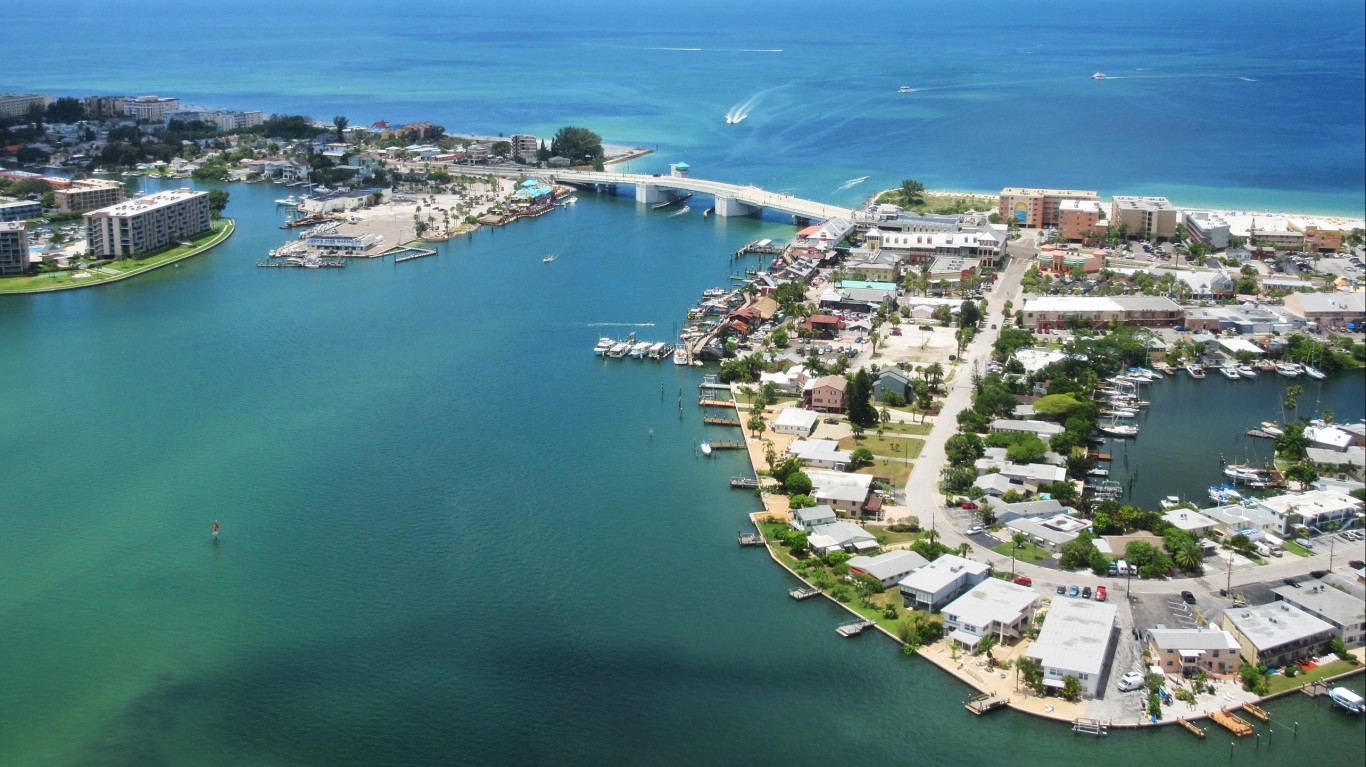
19. Madeira Beach, Florida
> Total population (2016): 4,343
> Homes at risk: 3,723
> Pct. of total pop. in at risk homes: 29.1%
> Value at risk: $1.23 billion
Madeira Beach, Florida, is about 11 miles northwest of St. Petersburg on Florida’s west coast. The area is no stranger to intense storms. One occurred in February of 2006 when between 8 and 11 inches of rain fell in about a five-hour period over a 5 mile-wide corridor from Madeira Beach northeast to west Tampa.
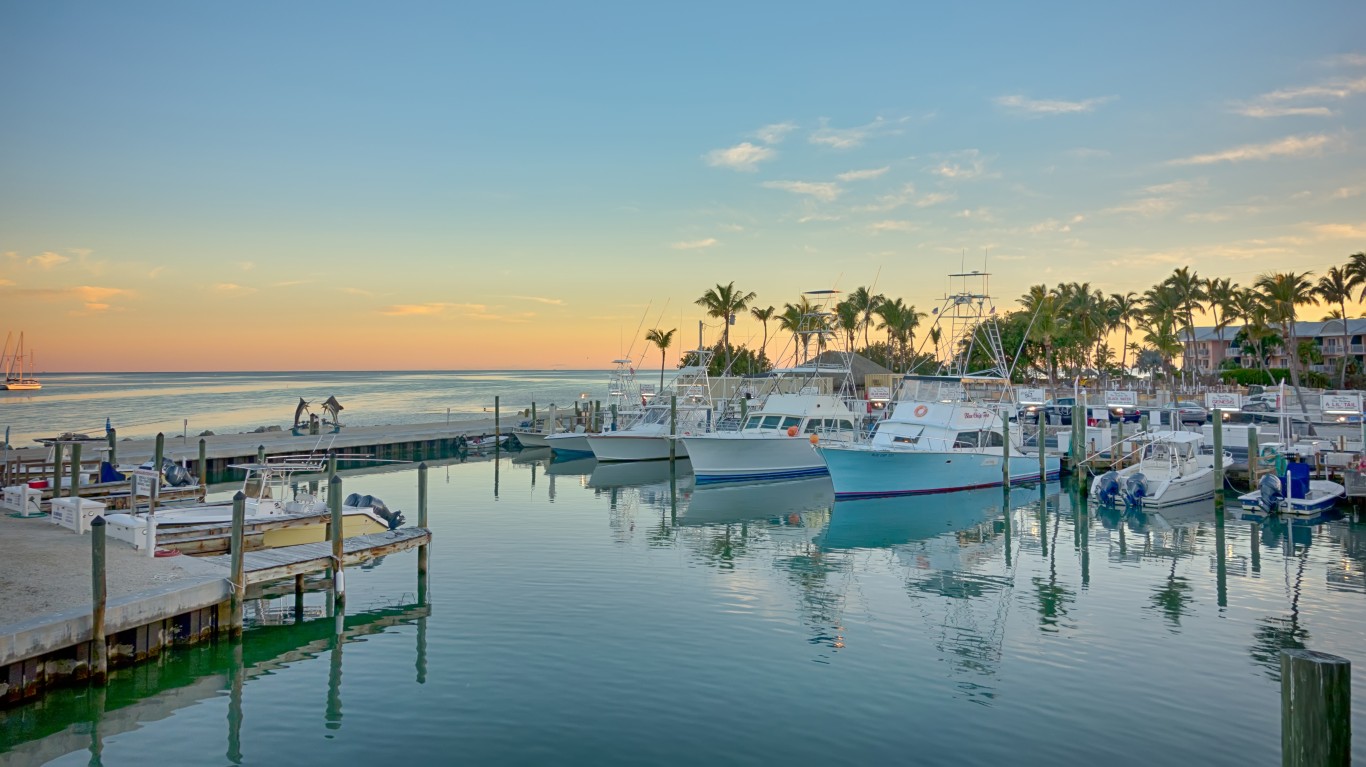
18. Key Largo, Florida
> Total population (2016): 10,024
> Homes at risk: 3,775
> Pct. of total pop. in at risk homes: 36.4%
> Value at risk: $2.17 billion
Key Largo, Florida, just off the Florida mainland, is one of three of the Florida Keys on the list. Thirty of the 32 coastal flood days over the 2005-2014 period were driven by climate change, according to a report from Climate Central. Key Largo is one of the areas in Florida that is particularly at risk of water inundation, according to a report from the Union of Concerned Scientists.
[in-text-ad-2]

17. Cudjoe Key, Florida
> Total population (2016): 1,812
> Homes at risk: 3,921
> Pct. of total pop. in at risk homes: 83.9%
> Value at risk: $1.72 billion
Cudjoe Key is among the most westerly of the Florida keys and is one of the most vulnerable of the keys to rising waters from climate change, according to data from the Union of Concerned Scientists. The Florida Keys overall are the area in the United States most susceptible to climate change, according to research from the The National Oceanic and Atmospheric Administration. The region is also prone to hurricanes. More than 83% of the population in Cudjoe is at risk of rising waters.
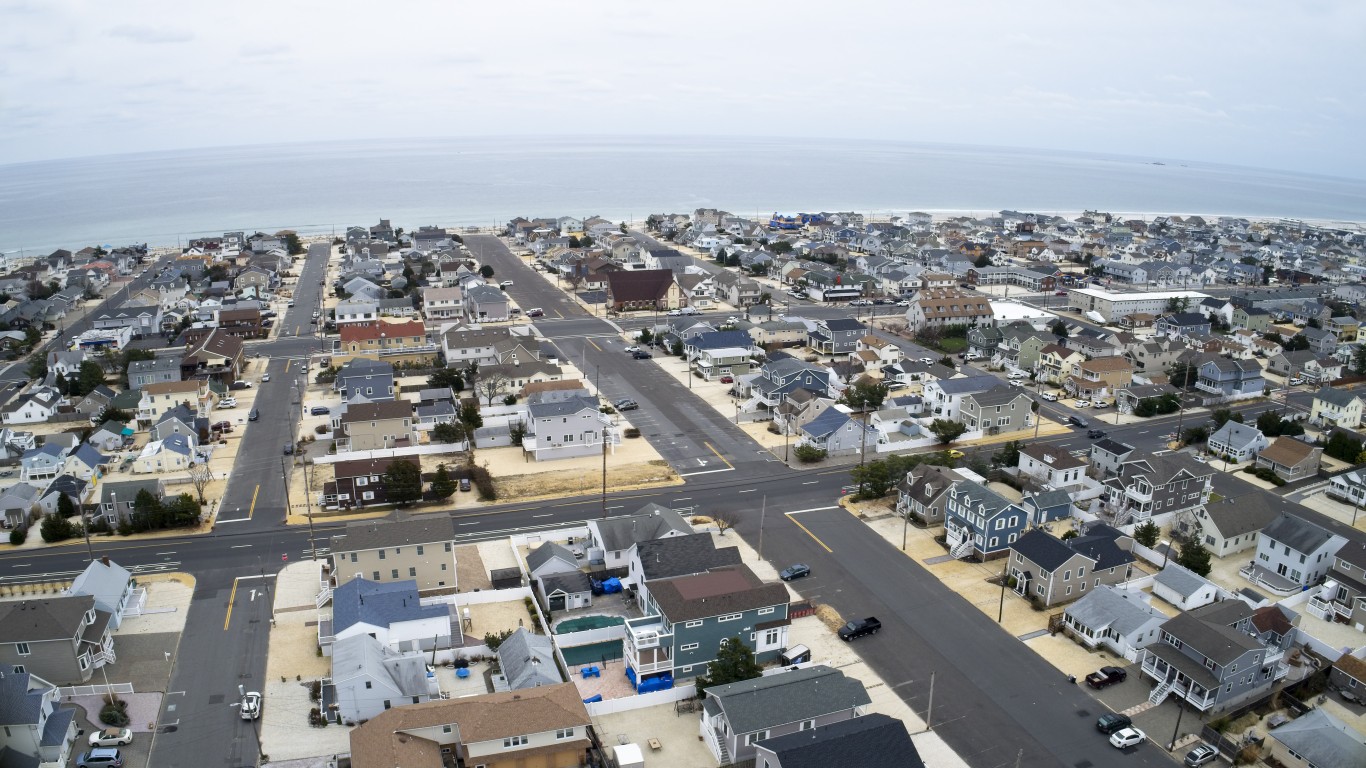
16. Lavallette, New Jersey
> Total population (2016): 2,026
> Homes at risk: 3,938
> Pct. of total pop. in at risk homes: 54.1%
> Value at risk: $1.97 billion
This Ocean County resort community was devastated by Superstorm Sandy in 2012, one of many Jersey Shore towns damaged by the tempest. In an NJ.com story, David Robinson, a climatologist at Rutgers University, explains that ocean temperatures off the Jersey Shore are rising and that future storms that will strike the Jersey coast will increase in intensity.
[in-text-ad]

15. Margate City, New Jersey
> Total population (2016): 6,250
> Homes at risk: 3,970
> Pct. of total pop. in at risk homes: 55.7%
> Value at risk: $1.90 billion
Margate City, New Jersey, is located just south of Atlantic City. The resort community had 229 days of coastal flooding in the 10-year period from 2005 to 2014, more than double the number of coastal flood days from the previous 10-year period, according to a 2016 Climate Central study covered by the New York Times.
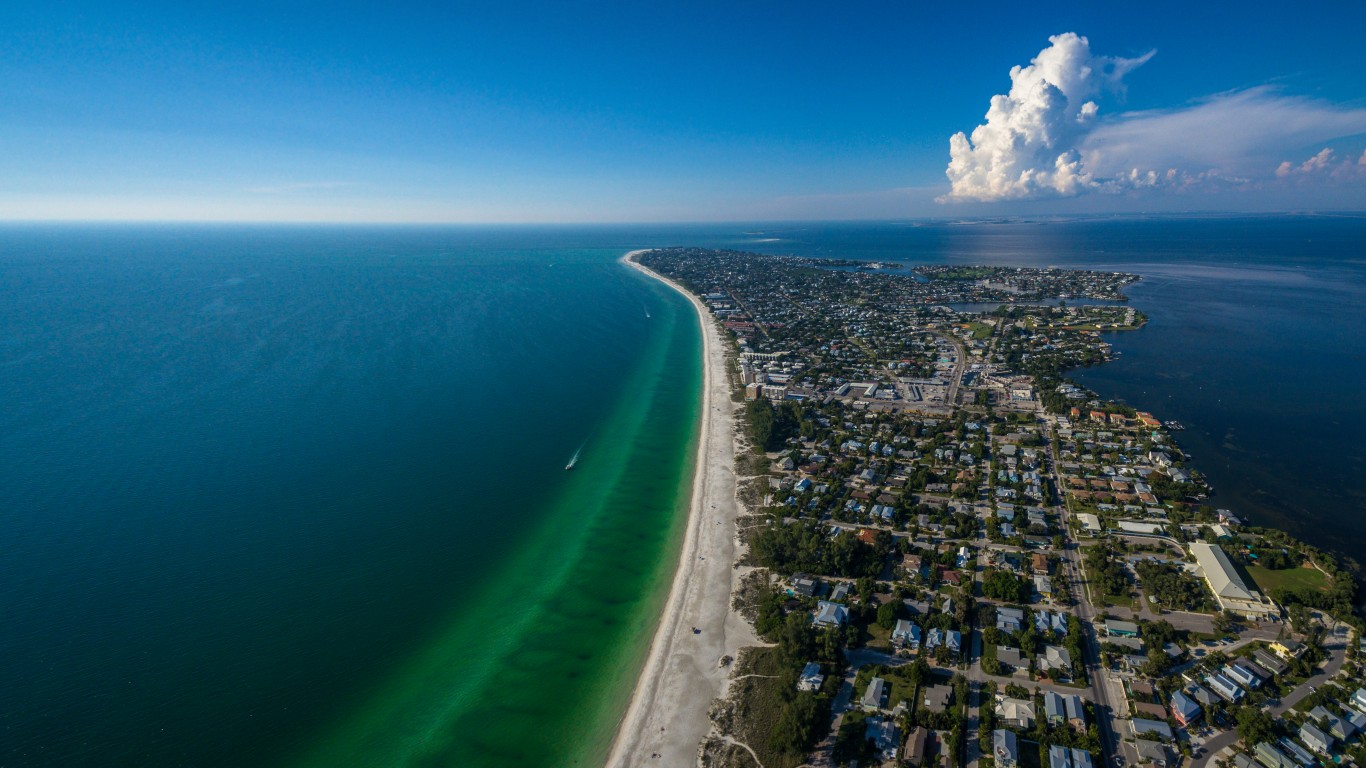
14. Holmes Beach, Florida
> Total population (2016): 4,119
> Homes at risk: 3,978
> Pct. of total pop. in at risk homes: 66.0%
> Value at risk: $1.67 billion
Holmes Beach, Florida, is located about 19 miles north of Sarasota on Anna Maria Island on Florida’s west coast. Town planners are addressing climate change by proposing to gradually raise city streets, build seawalls, and add more stormwater drains.

13. St. Pete Beach, Florida
> Total population (2016): 9,528
> Homes at risk: 4,242
> Pct. of total pop. in at risk homes: 31.3%
> Value at risk: $1.56 billion
The city of St. Pete Beach, Florida, is a barrier island community, located off the mainland of St. Petersburg. According to the city’s website, nearly 28% of the residences in St. Pete Beach are owned by people claiming primary residence elsewhere. Climate Central said there is a 57% risk of at least one flood over 5 feet occurring at St. Pete Beach between today and 2050.
[in-text-ad-2]
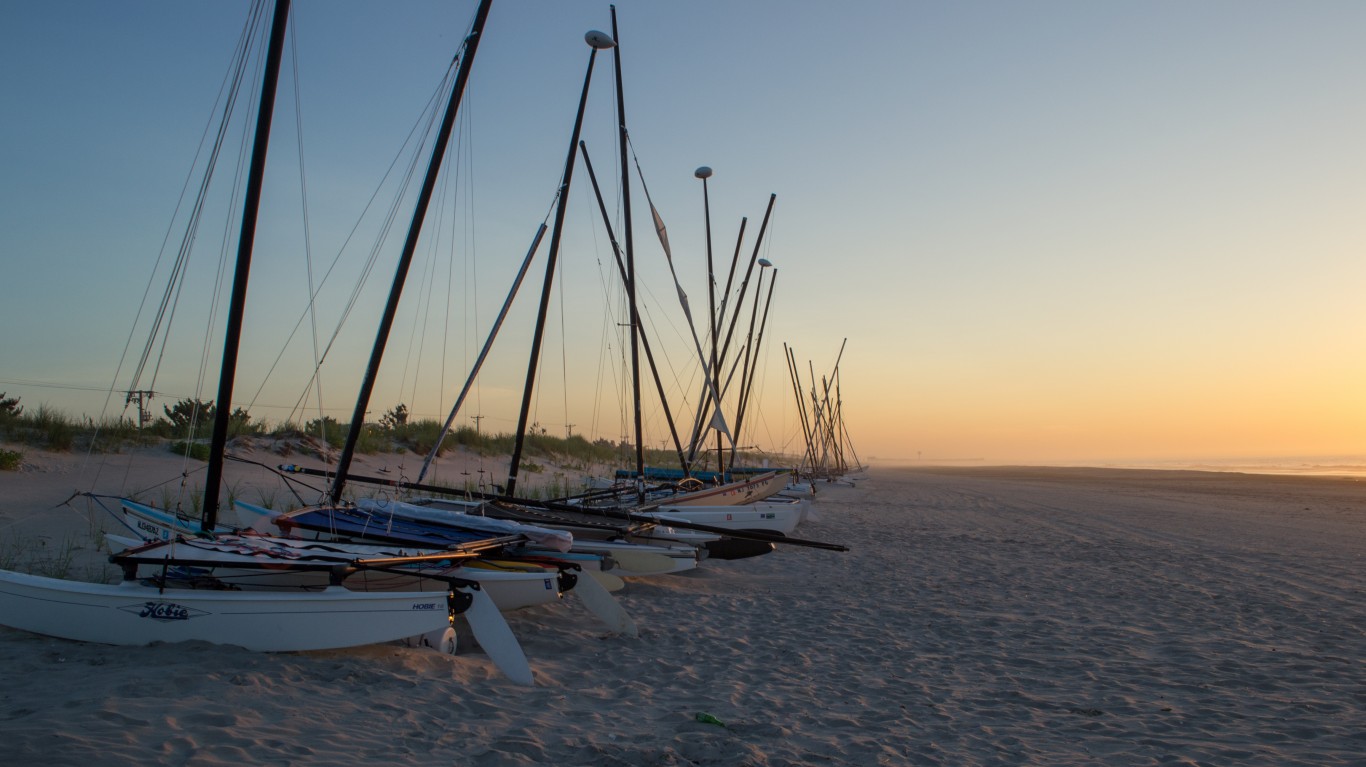
12. Sea Isle City, New Jersey
> Total population (2016): 1,905
> Homes at risk: 4,266
> Pct. of total pop. in at risk homes: 61.8%
> Value at risk: $2.55 billion
Sea Isle City, New Jersey, located in Cape May County in southern New Jersey, is a resort community whose summer population swells to 20 times the permanent population. It is one of the many Jersey coastal communities that was blasted by Superstorm Sandy in 2012. Currently, over 4,000 area homes are at risk of rising sea levels by 2060 if action is not taken.
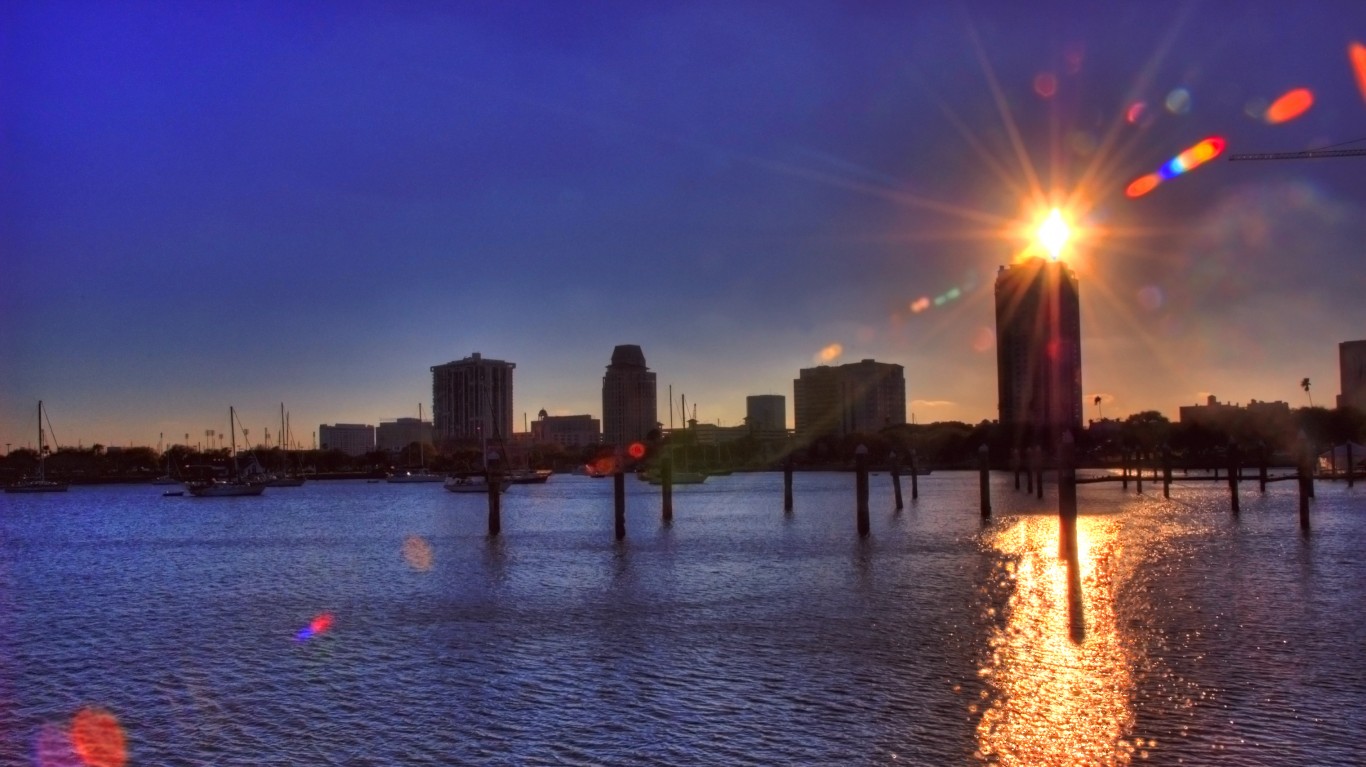
11. St. Petersburg, Florida
> Total population (2016): 253,585
> Homes at risk: 4,664
> Pct. of total pop. in at risk homes: 4.4%
> Value at risk: $1.36 billion
According to the St. Petersburg, Florida, website, the city is crafting plans to address climate change, including making stormwater and wastewater infrastructure improvements based on a projected sea level rise that is based on a tide gauge the city has used since 1946.
[in-text-ad]
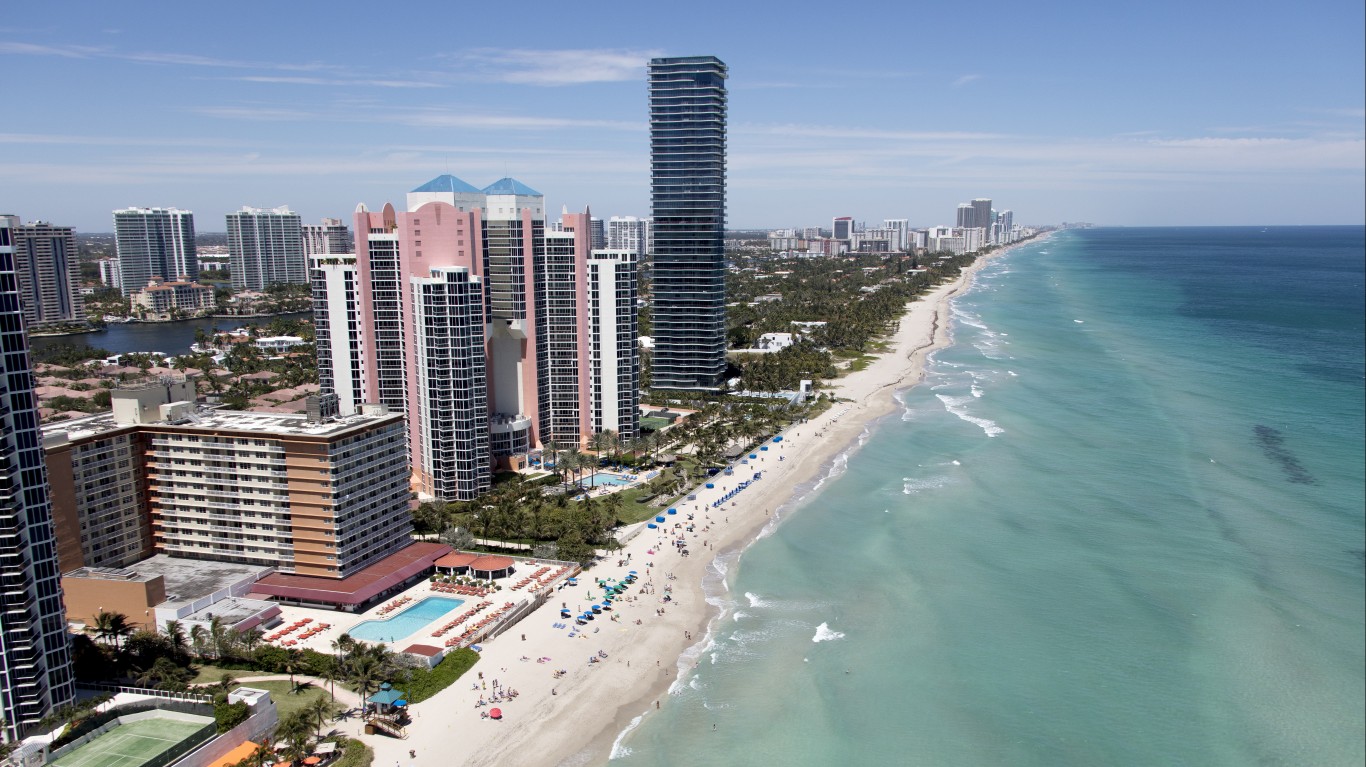
10. Sunny Isles Beach, Florida
> Total population (2016): 21,937
> Homes at risk: 6,343
> Pct. of total pop. in at risk homes: 20.1%
> Value at risk: $2.55 billion
Sunny Isles Beach, Florida, is located about 21 miles north of Miami and is one of nine Florida towns on this list. Climate Central predicts the resort town has a 73% risk of at least one flood over 3 feet taking place by 2050. In order to address climate change, the city has made stormwater improvements, purchased land for green space, and planted hundreds of trees, according to the website.
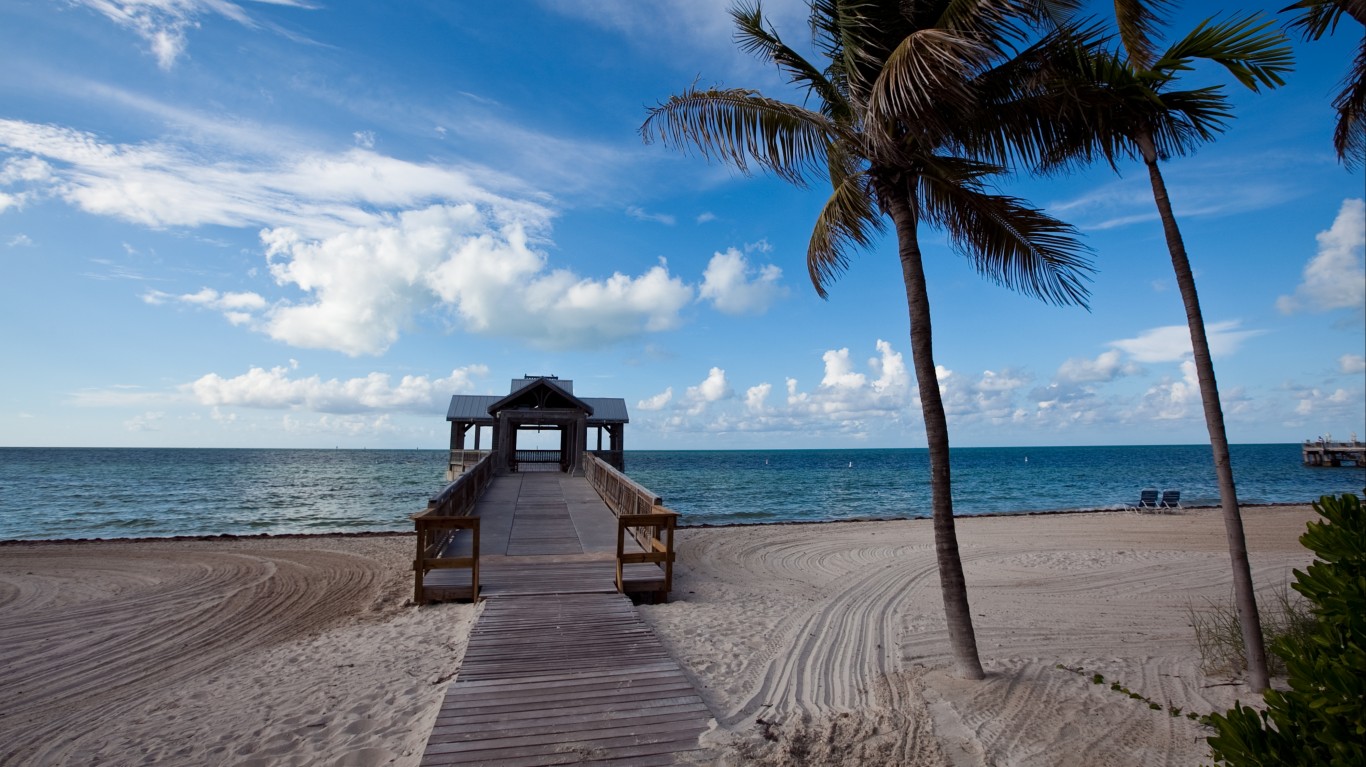
9. Key West, Florida
> Total population (2016): 26,039
> Homes at risk: 6,921
> Pct. of total pop. in at risk homes: 36.7%
> Value at risk: $3.33 billion
Key West, Florida, is the southernmost point of the continental United States. It is known more for its snorkeling and scuba diving. With an average elevation of 4.7 feet above sea level, Key West is vulnerable to storm damage. Residents have learned to live with frequent flooding. A NOAA tidal measure in Key West has tallied an increase of 9 inches in sea level over the past century. To combat flooding, Key West has invested in one-way valves on storm drains to block seawaters from surging on to city streets.

8. Atlantic City, New Jersey
> Total population (2016): 39,306
> Homes at risk: 7,055
> Pct. of total pop. in at risk homes: 34.5%
> Value at risk: $1.05 billion
It’s a good bet that Atlantic City, New Jersey, one of the East Coast’s gambling meccas, will have flooding issues in the years to come. Nearly seven years ago, Superstorm Sandy shattered windows of casinos, forced residents to evacuate the city, and tore up the city’s famed boardwalk. Climate Central predicts a 74% risk of at least one flood over 5 feet occurring between now and 2050 in the Atlantic City.
[in-text-ad-2]

7. Wildwood, New Jersey
> Total population (2016): 5,192
> Homes at risk: 8,109
> Pct. of total pop. in at risk homes: 33.8%
> Value at risk: $2.38 billion
Wildwood, New Jersey, less than hour south of Atlantic City, is famed for its Doo Wop-era motels. It also suffered during Superstorm Sandy. A report from the U.S. Army Corps of Engineers on the New Jersey Back Bay region this past March said construction of seawalls in Wildwood and Sea Isle City, will “manage risk for both high and low frequency events.” Construction of those storm walls may protect some of the more than 8,000 area homes at high flood risk.
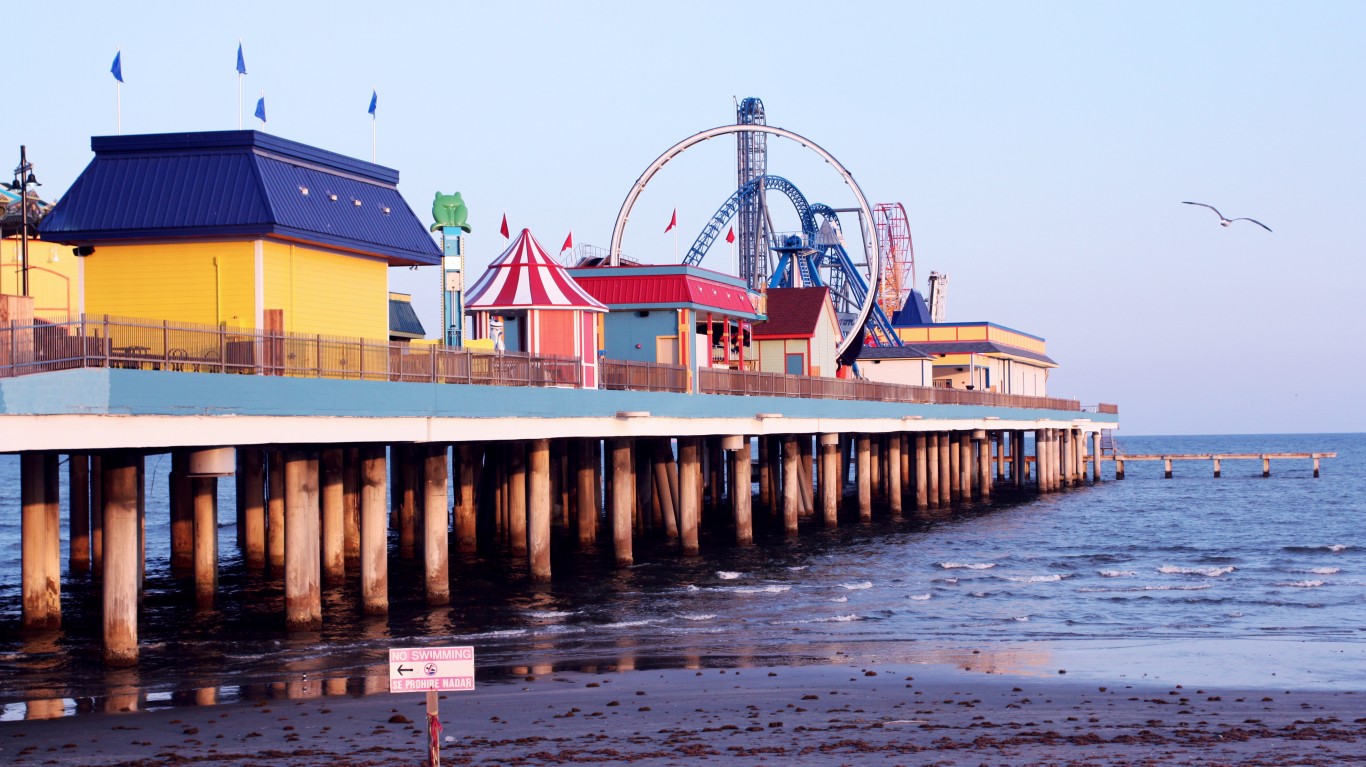
6. Galveston, Texas
> Total population (2016): 49,443
> Homes at risk: 8,182
> Pct. of total pop. in at risk homes: 17.7%
> Value at risk: $2.46 billion
Galveston, Texas, is the site of the worst natural disaster in the nation’s history, when in 1900, a hurricane swept over the city, killing 8,000 people. Galveston is about 51 miles southeast of downtown Houston, and the island city juts out into the Gulf Mexico. Climate Central projects a risk of 37% a flood of more than 9 feet will happen between now and 2050.
[in-text-ad]

5. Hilton Head Island, South Carolina
> Total population (2016): 39,651
> Homes at risk: 8,194
> Pct. of total pop. in at risk homes: 17.2%
> Value at risk: $4.66 billion
Golf haven Hilton Head, South Carolina, is at risk of soon going under water. Climate Central projects an 86% risk of at least one flood over 4 feet occurring between now and 2050. Over the 10-year period that ended in 2014, Hilton Head had 152 coastal flood days, compared with 115 for the previous 10-year span.

4. North Beach Haven, New Jersey
> Total population (2016): 2,250
> Homes at risk: 10,293
> Pct. of total pop. in at risk homes: 57.5%
> Value at risk: $7.78 billion
North Beach Haven, New Jersey, is a resort town on Long Beach Island, a long, narrow strip of land. The town is about an hour north of Atlantic City. Superstorm Sandy tore apart houses and left piles of sand in the streets of North Beach Haven in 2012. Climate Central projects a 74% risk of at least one flood over 5 feet taking place between today and 2050.
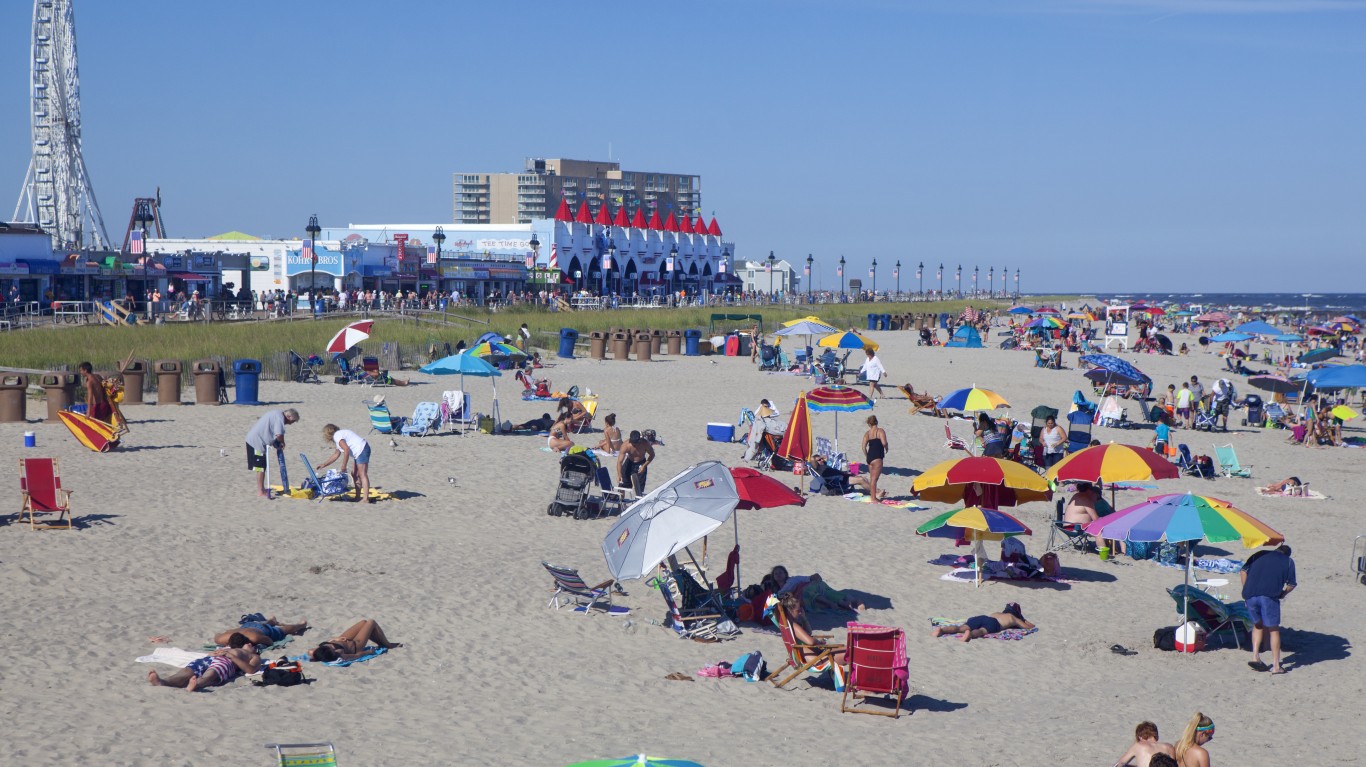
3. Ocean City, New Jersey
> Total population (2016): 11,430
> Homes at risk: 11,110
> Pct. of total pop. in at risk homes: 53.1%
> Value at risk: $5.89 billion
Ocean City, New Jersey, located about a half-hour south of Atlantic City, touts itself as a family-friendly beach resort that is also a dry town, meaning no alcohol can be purchased there. Sea-level increases and frequent flooding episodes have cost the town about $530 million in lost property value over the period from 2005 to 2017, according to a study done by data science organization First Street Foundation and Columbia University.
[in-text-ad-2]
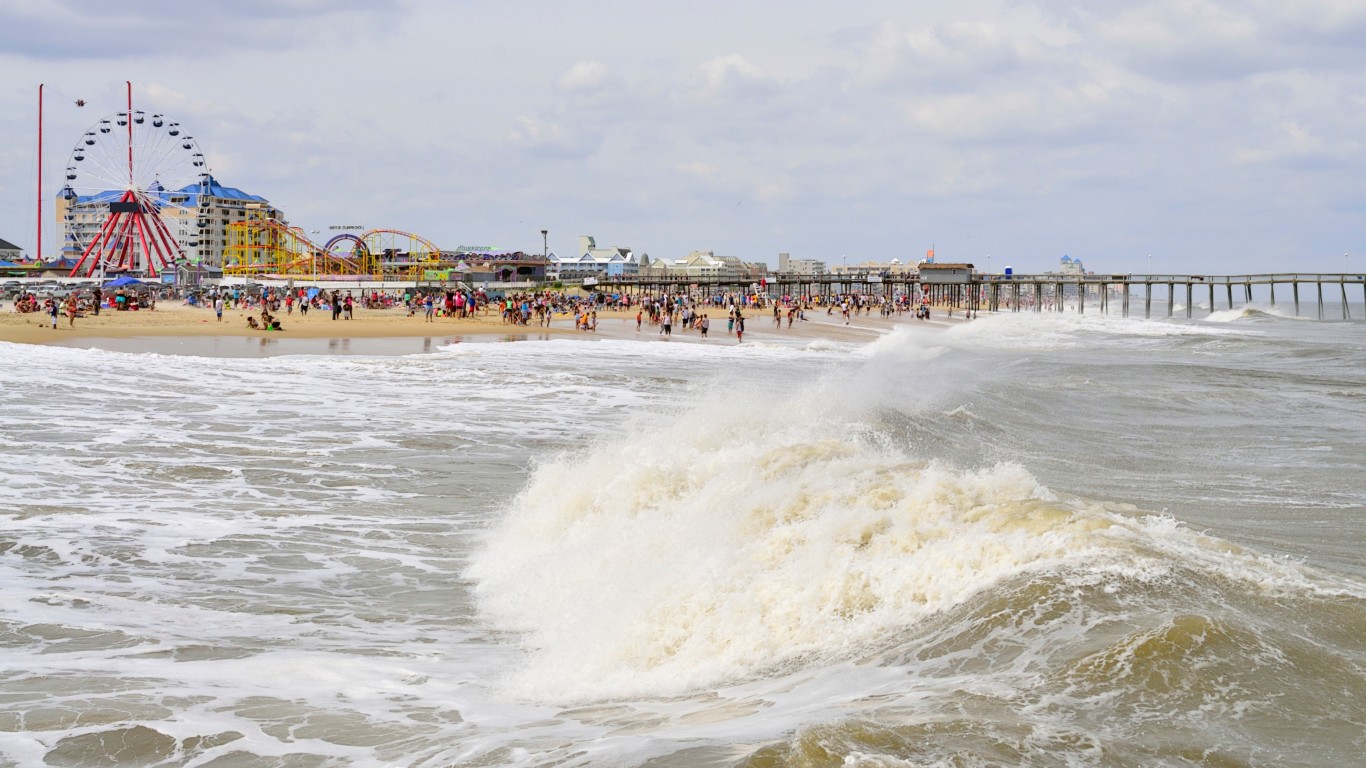
2. Ocean City, Maryland
> Total population (2016): 7,041
> Homes at risk: 11,478
> Pct. of total pop. in at risk homes: 34.9%
> Value at risk: $2.90 billion
Another Ocean City on our list is Ocean City, Maryland, just south of Delaware. There is a 93% risk at least one flood over 5 feet will occur between today and 2050 in the Ocean City area, according to Climate Central. Maryland’s Eastern Shore is one of the communities that is at higher risk of rising waters, according to a report from the Union of Concerned Scientists, which also notes that half or more of the usable land in Ocean City may be chronically inundated by 2100.

1. Miami Beach, Florida
> Total population (2016): 91,784
> Homes at risk: 25,986
> Pct. of total pop. in at risk homes: 36.1%
> Value at risk: $16.63 billion
Miami Beach, Florida, is the U.S. city most likely to soon be under water. The city has more people and more property at risk of rising water than any other American city on our list. Miami Beach will face chronic inundation by 2035, according to the Union of Concerned Scientists. Nearly 26,000 homes area are at risk of flooding by 2060.
Methodology
To identify the beach towns that will soon be under water, 24/7 Wall St. reviewed ZIP-code level data on the value of property and the number of homes threatened by rising sea levels in 2060, which was then aggregated to the level of city and town. ZIP-code level data came from the Union of Concerned Scientists report “Underwater: Rising Seas, Chronic Floods, and the Implications for US Coastal Real Estate,” published in 2018. We also used data from Climate Central, an organization of concerned scientists and journalists reporting on the impact of climate change.
100 Million Americans Are Missing This Crucial Retirement Tool
The thought of burdening your family with a financial disaster is most Americans’ nightmare. However, recent studies show that over 100 million Americans still don’t have proper life insurance in the event they pass away.
Life insurance can bring peace of mind – ensuring your loved ones are safeguarded against unforeseen expenses and debts. With premiums often lower than expected and a variety of plans tailored to different life stages and health conditions, securing a policy is more accessible than ever.
A quick, no-obligation quote can provide valuable insight into what’s available and what might best suit your family’s needs. Life insurance is a simple step you can take today to help secure peace of mind for your loved ones tomorrow.
Click here to learn how to get a quote in just a few minutes.
Thank you for reading! Have some feedback for us?
Contact the 24/7 Wall St. editorial team.
 24/7 Wall St.
24/7 Wall St. 24/7 Wall St.
24/7 Wall St.

